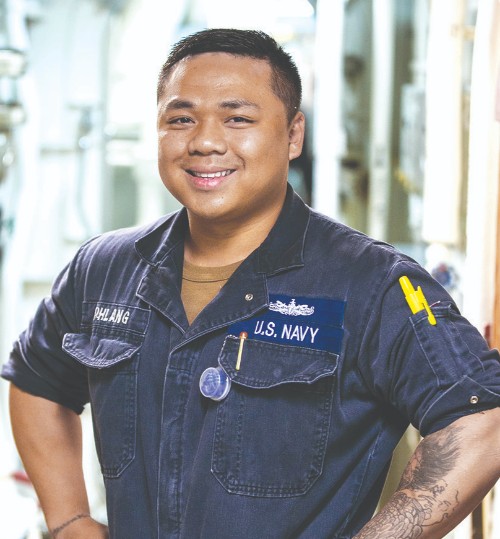
By Mass Communication Specialist 1st Class Robert Zahn, Navy Office of Community Outreach
YOKOSUKA, Japan – Seaman Ratanak Phlang, a native of Lowell, Massachusetts, joined the Navy for the opportunities it provides for him.
Now, two years later and half a world away at Fleet Activities Yokosuka, Phlang serves aboard the Arleigh Burke-class guided-missile destroyer USS Curtis Wilbur, patrolling one of the world’s busiest maritime regions as part of the leading-edge of U.S. 7th Fleet.
“If you can make it on this type of ship, you can make it anywhere,” said Phlang. “It’s a tough job with a grueling schedule and you’ll never know when you’ll leave or come back but it’s still a great experience.”
Phlang, a 2012 graduate of Lowell High School, works in the engineering department aboard the Yokosuka, Japan-based ship, one of several in its class forward-deployed to the region.
“I work on the ventilation system and the damage control equipment on the ship so the crew can effectively fight fires,” said Phlang.
Phlang credits success in the Navy to some of the lessons learned in Lowell.
“My mom taught me a lot, to be responsible mostly,” said Phlang.
U.S. 7th Fleet spans more than 124 million square kilometers, stretching from the International Date Line to the India/Pakistan border; and from the Kuril Islands in the North to the Antarctic in the South. U.S. 7th Fleet’s area of operations encompasses 36 maritime countries and 50 percent of the world’s population with between 50-70 U.S. ships and submarines, 140 aircraft, and approximately 20,000 sailors.
With more than 50 percent of the world’s shipping tonnage and a third of the world’s crude oil passing through the region, the United States has historic and enduring interests in this part of the world. The Navy’s presence in Yokosuka is part of that long-standing commitment.
“The Navy is forward-deployed to provide security and strengthen relationships in a free and open Indo-Pacific. It’s not just the ships and aircraft that have shown up to prevent conflict and promote peace,” said Vice Adm. Phil Sawyer, commander, U.S. 7th Fleet. “It is, and will continue to be our people who define the role our Navy plays around the world. People who’ve made a choice, and have the will and strength of character to make a difference.”
Destroyers are warships that provide multi-mission offensive and defensive capabilities. They are 510 feet long and armed with tomahawk land-attack cruise missiles, Standard Missile-3 and newer variants of the SM missile family, advanced gun systems and close-in gun systems. Destroyers are deployed globally and can operate independently or as part of carrier strike groups, surface action groups, or amphibious readiness groups.
Their presence helps the Navy control the sea. Sea control is the precondition for everything else the Navy does. It cannot project power, secure the commons, deter aggression, or assure allies without the ability to control the seas when and where desired.
USS Curtis Wilbur has anti-aircraft capability armed with long range missiles intended for air defense to counter the threat to friendly forces posed by manned aircraft, anti-ship, cruise and tactical ballistic missiles.
Serving in the Navy means Phlang is part of a world that is taking on new importance in America’s focus on rebuilding military readiness, strengthening alliances and reforming business practices in support of the National Defense Strategy.
A key element of the Navy the nation needs is tied to the fact that America is a maritime nation, and that the nation’s prosperity is tied to the ability to operate freely on the world’s oceans. More than 70 percent of the Earth’s surface is covered by water; 80 percent of the world’s population lives close to a coast; and 90 percent of all global trade by volume travels by sea.
“Our priorities center on people, capabilities and processes, and will be achieved by our focus on speed, value, results and partnerships,” said Secretary of the Navy Richard V. Spencer. “Readiness, lethality and modernization are the requirements driving these priorities.”
There are many ways for sailors to earn distinction in their command, community, and career. Phlang is most proud of being able to save enough money to buy his mother a car.
“My biggest accomplishment was buying my mom a car because she was really in need of a nicer car,” said Phlang. “She deserves it, she worked two jobs while taking care of three kids. She would sometimes leave at four in the morning and not come home until almost midnight, sleep a few hours, then go back to work. I’m really grateful for what she did for us.”
As a member of one of the U.S. Navy’s most relied upon assets, Phlang and other sailors know they are part of a legacy that will last beyond their lifetimes, contributing to the Navy the nation needs.
“Serving in the Navy is an honor and an experience I never thought I’d go through,” said Phlang. “It has taught me how to be a man.”



